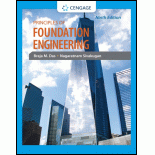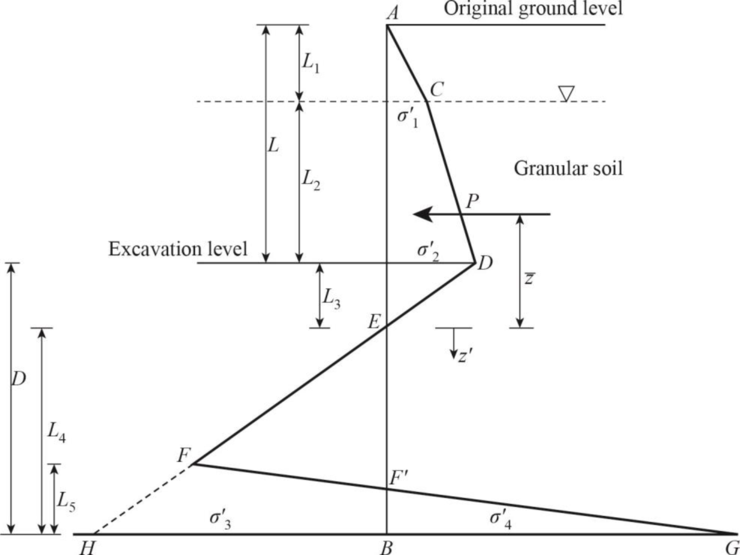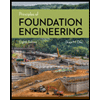
Concept explainers
Refer to Figure 18.9. A cantilever sheet pile is driven into a granular soil where the water table is 2 m (L1) below the top of the sand. The properties of the sand are
Find the required actual depth of the sheet pile.
Answer to Problem 18.1P
The required actual depth of the sheet pile is
Explanation of Solution
Given information:
The depth of water level below the sand
The angle of internal friction for sand
The unit weight of the sand
The saturated unit weight of the sand
The depth below the ground level (L) is 6 m.
Calculation:
Show the cross section of cantilever sheet pile with dimensions as in Figure (1).

Refer Figure (1),
Find the depth of water table level
Find the rankine active pressure coefficient
Find the rankine passive pressure coefficient
Find the difference between the rankine active pressure coefficient and rankine passive pressure coefficient:
Find the effective unit weight of sand
At the water table level:
Find the intensity of the active pressure to the right of the pile
At the excavation level:
Find the intensity of the active pressure to the right of the pile
Find the depth below the dredge line
Find the area of the pressure diagram (P):
Find the area of the pressure diagram into center of pressure
Find the center of pressure to the area
Find the intensity of the passive pressure
Find the area
Find the area
Find the area
Find the area
Find the depth below point E
Use trial and error method to calculate depth below point E
Try
Substitute 4.30 m for
Hence, the assumption is correct.
The depth below point E is 4.30 m.
Find the depth below the dredge line to bottom of the pile (D):
Increase the depth below the dredge line to bottom of the pile by 30%. The depth below the dredge line to bottom of the pile (D) is 6.214 m.
Find required actual depth of the sheet pile
Thus, the required actual depth of the sheet pile is
Want to see more full solutions like this?
Chapter 18 Solutions
Principles of Foundation Engineering
- A 5 m wide braced excavation is made in a saturated clay, as shown in Figure P19.1, with the following properties: c =20 kN/m?, 4= 0, and y = 18.5 kN/m³. The struts are spaced at 5 m center to center in plan. a. Determine the strut forces. b. Determine the section modulus of the sheet pile required, assuming oall = 170 MN/m². c. Determine the maximum moment for the wales at levels B and C. 5 m A 1 m | 3 m B | 2 m Imarrow_forwardProblem #1 The figure below shows a cantilever sheet-pile wall penetrating a granular soil. Here, L₁ = 4 m, L₂ = 8 m, unit weight above water table= 16.1 kN/m³, saturated unit weight = 5 18.2 kN/m³, and friction angle of sand = 32 degrees. a. What is the theoretical depth of embedment, D? b. For a 30% increase in D, what should be the total length of the sheet piles? c. Determine the theoretical maximum moment of the sheet pile. d. If the allowable flexural stress = 170 MPa, compute the required section modulus of the sheet pile. Water table Dredge line Sand Y <=0 Sand Ysat c'=0 Sand Ysat c'=0arrow_forwardQuestion 3 A new underground tunnel section is designed by a geotechnical consultant. For the underground station a 5 m wide braced excavation is made in a saturated clay as shown in Figure Q3 with unit weight, y = 18.5 kN/m², friction angle, o = 0° and cohesion, c = 20 kN/m?. The struts are spaced at 5 m center to center in plan. Refer Appendix 1 to select the sheet-pile section. i. Draw the strut forces. ii. Determine the section modulus of the sheet pile needed. Assume oall = 170 MN/m? iii. Determine the maximum moment for the wales at levels B and C. Show a complete answer, including all numerical values and necessary diagrams. 5 m 3 m B 2 marrow_forward
- Problem #1 The figure below shows a cantilever sheet-pile wall penetrating a granular soil. Here, L1 = 4 m, L2 = 8 m, unit weight above water table= 16.1 kN/m3, saturated unit weight = 5 18.2 kN/m3, and friction angle of sand = 32 degrees. a. What is the theoretical depth of embedment, D? b. For a 30% increase in D, what should be the total length of the sheet piles? c. Determine the theoretical maximum moment of the sheet pile. d. If the allowable flexural stress = 170 MPa, compute the required section modulus of the sheet pile.arrow_forwardQuestion 3 The flownet for an excavation supported by sheet pile walls is shown in Figure Q3. The soil being excavated is a uniform fine sand with a coefficient of permeability (k) of 5×104 m/s. The width of the trench is 5 m, with a length of 50 m. A constant external water level of 2 m is maintained at the ground level. Ground level 2m 6m 6m 6m ▼ K Line of symmetry- 5m Sheet pile wall 9m (c) Determine the pore water pressure (u) at Point A. Figure Q3 (a) Explain the physical significance of a flownet. In other words, explain what these lines represent. (b) Determine the total water flow rate (Q) at the excavation floor. K (d) If the excavation was carried out on the Moon, determine the total water flow rate (Q) at the excavation floor again (assuming that the gravitational acceleration on the Moon is 1.6 m/s²).arrow_forwardEx: The figure below is a proposed weir floor with three vertical piles. calculate the uplift pressure distribution under the floor of the weir at key point by khosla's creep flow theory? 106.00 102.25 1:5 100.50 100.00 98.50 99.25 [97.25L b = 15.75 b = 34.75 D, [93.00 93.00 b, = 15 b, = 34 91.00 b = 50.5arrow_forward
- Q3. Two meters of compacted fill (y= 20 kN/m³) is placed over a large area (Figure 4). A rectangular foundation of size 4 m x 5 m is constructed at the site with its base located at the existing ground surface. GWT is found at a depth of 3 m below the existing ground surface. a). Calculate and plot the in-situ vertical effective stress profile to a depth of 16 m below the existing ground surface prior to fill and footing placement. Use points with z = +2, +1, 0, -1, -2, -3, -5, -10, -13, -16 m (with z measured from the existing ground surface). b). Calculate and plot the additional effective stress due to the fill to a depth of 16 m. Use the same points as in part a). c). If the load applied on the foundation is 4 MN, calculate and plot the effective stress increase due to the footing to a depth of 16 m. Use the 2:1 approximate method and the same points as in part a). Summarize your calculations in an Excel spreadsheet and present sample calculations for z = 0, -3, -10 and -16 m (with…arrow_forwardA 3 m high embankment is to be constructed as shown in the figure. If the unit weight of soil used in the embankment is 19 kN/m, calculate the vertical stress due to the embankment loading at points P1, P2, and P3. 10.5 7.5 6 4.5 CE +4.5 3.0 |y= 19 kN/m B 3.0 -3.0 1 P3 -3.0- Note: All dimensions are in metresarrow_forward1. The following is a sketch of the proposed embankment, calculate the addition of vertical stress (Bousinesq method / graph below) at the depths of points A and B. Assume the unit weight of the soil stockpile = 20 kN / m3. 2. Calculate the added vertical stress at points A and B as deep as Z = 8 m, under the rectangular loadarrow_forward
- 1. Figure 3 shows a cantilever sheet pile wall, determine the: Sand 3 m y = 16 kN/m3 O' = 30 %3! Sand Ysat = 19 kN/m3 O' = 30 6 m Clay Ysat = 19 kN/m3 Cu = 54 kPa D %3D Figure 3 (a) Theoretical depth of embedment,arrow_forwardP-3 Refer to Figure, for which L, = 2.4 m, L2 = 4.6 m, y = 15.7 kN/m³, Ysat = 17.3 kN/m³, and o'=30°, and c= 35 kN/m². Assuming Sand c' = 0 C = Water table free earth support method: a. What is the theoretical depth of embedment, D? Sand Ysat c' = 0 b. What length of sheet piles is needed? c. Determine the theoretical maximum moment in the sheet pile. d. Choose a sheet pile, from next page, if the the steel pile has a oall = 172 MN/m². %3D Clay D C b'= 0arrow_forwardA vertical sheet pile supports a horizontal backfill having a height of 6 m. The backfill has a unit weight of 19 KN/m² and an angle of internal friction of 30°. Determine the required depth of penetration. A 3 m B 4m 4.5 m D 5.5 marrow_forward
 Principles of Foundation Engineering (MindTap Cou...Civil EngineeringISBN:9781305081550Author:Braja M. DasPublisher:Cengage Learning
Principles of Foundation Engineering (MindTap Cou...Civil EngineeringISBN:9781305081550Author:Braja M. DasPublisher:Cengage Learning
